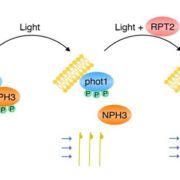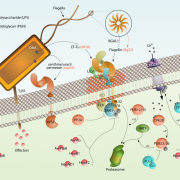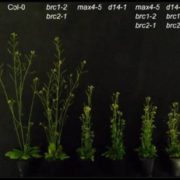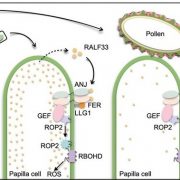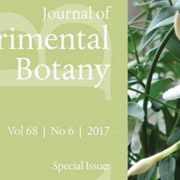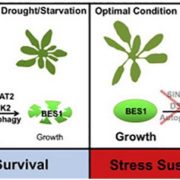Calcium-mediated ABA signaling negatively regulated by CBL-CIPK system in guard cells (Plant Physiol.)
 Abscisic acid (ABA) plays a critical role in the opening and closing of the stomatal pore. This stomatal movement is essential for homeostasis, photosynthesis and stress responses. An influx of calcium ions and an increase the cytoplasmic calcium concentration of the guard cells are an early event in ABA signaling. It is not clear what the negative regulators of this process are and how calcium connects with potassium ion fluxes and vacuolar convolution. Song and colleagues used Arabidopsis thaliana mutants to examine the role of ABA and calcium in stomatal movement though phenotypic studies. The null mutant of Protein S-Acyl Transferase 10 (pat10-1) is hypersensitive to ABA-induced stomatal closure and vacuolar convolution. PAT10 is essential for the tonoplast association of Calcineurin B-Like protein 2 (CBL2) and CBL3. Loss of CBL2 and CBL3 results in plants that have phenotypes similar to pat10-1. CBL-Interacting Protein Kinase 9 (CIPK9) and CIPK17 were also identified as proteins that interact with the PAT10-CBL2/CBL3 system. Loss of PAT10-CBL2/3-CIPK9/17 system increases the drought tolerance of Arabidopsis. The PAT10-CBL2/CIPK3-CIPK9/17 system positively regulates vacuolar potassium ion accumulation and negatively regulates calcium-mediated ABA signaling. (Summary by Julia Miller) Plant Physiol. 10.1104/pp.18.00377
Abscisic acid (ABA) plays a critical role in the opening and closing of the stomatal pore. This stomatal movement is essential for homeostasis, photosynthesis and stress responses. An influx of calcium ions and an increase the cytoplasmic calcium concentration of the guard cells are an early event in ABA signaling. It is not clear what the negative regulators of this process are and how calcium connects with potassium ion fluxes and vacuolar convolution. Song and colleagues used Arabidopsis thaliana mutants to examine the role of ABA and calcium in stomatal movement though phenotypic studies. The null mutant of Protein S-Acyl Transferase 10 (pat10-1) is hypersensitive to ABA-induced stomatal closure and vacuolar convolution. PAT10 is essential for the tonoplast association of Calcineurin B-Like protein 2 (CBL2) and CBL3. Loss of CBL2 and CBL3 results in plants that have phenotypes similar to pat10-1. CBL-Interacting Protein Kinase 9 (CIPK9) and CIPK17 were also identified as proteins that interact with the PAT10-CBL2/CBL3 system. Loss of PAT10-CBL2/3-CIPK9/17 system increases the drought tolerance of Arabidopsis. The PAT10-CBL2/CIPK3-CIPK9/17 system positively regulates vacuolar potassium ion accumulation and negatively regulates calcium-mediated ABA signaling. (Summary by Julia Miller) Plant Physiol. 10.1104/pp.18.00377


